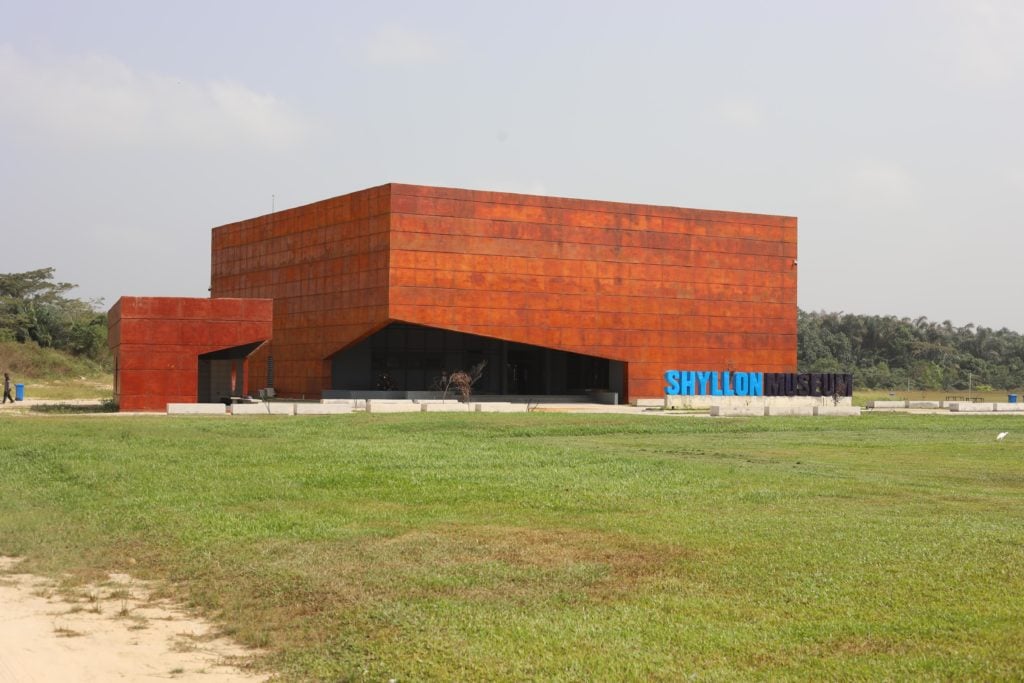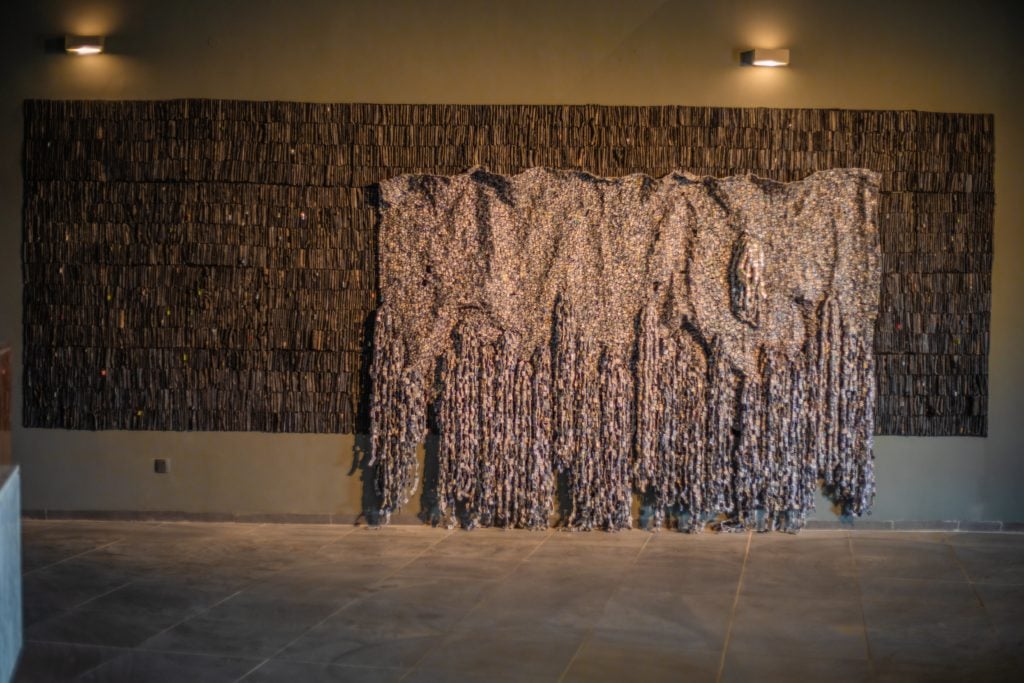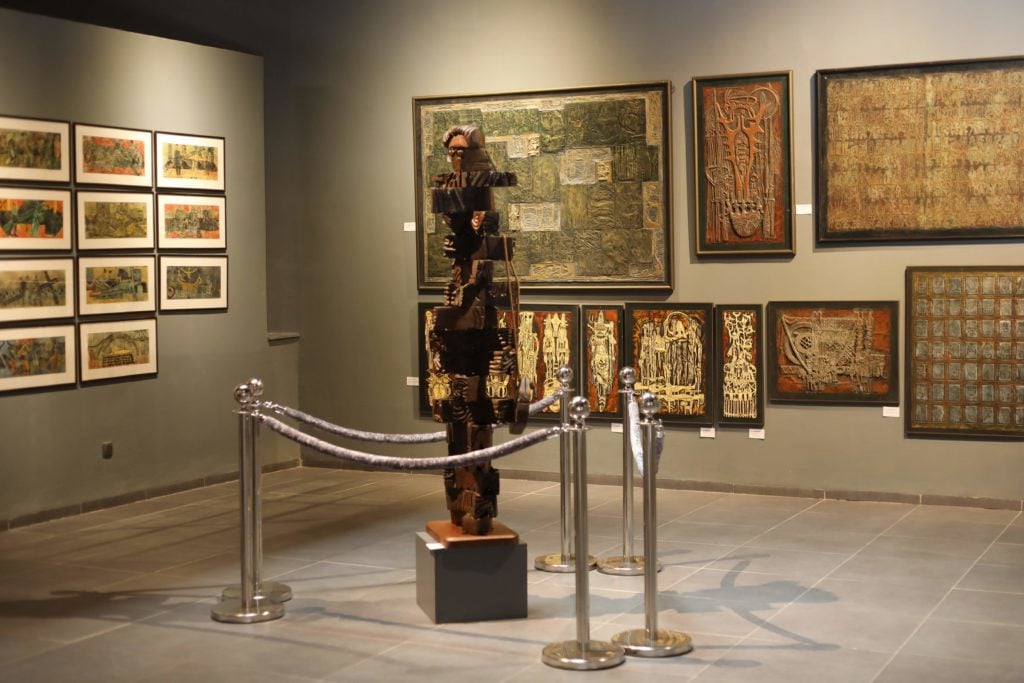Art World
With Help from a Nigerian Prince, a Bold New Contemporary Art Museum Is Set to Open in Lagos
“Culture and art are absolutely crucial to the health of a nation," says Prince Shyllon, one of the country's biggest collectors.

“Culture and art are absolutely crucial to the health of a nation," says Prince Shyllon, one of the country's biggest collectors.

Rebecca Anne Proctor

You have to drive around an hour on a bumpy road from Lagos’s affluent neighborhood of Victoria Island to reach the pristine grassy site of the Pan-Atlantic University, Lagos, the location of the new Yemisi Shyllon Museum of Art, due to officially open this March.
It is named after Yemisi Shyllon, a Yoruba prince from Abeokuta, the capital of the Ogun State in southwest Nigeria, who is arguably Nigeria’s biggest art collector and the university museum’s main donor. A few years ago, he reportedly gave $1.7 million to build the museum and maintain it over a period of 15 years.
Over the past 40 years, the 67-year-old prince has acquired around 7,000 artworks in addition to over 55,000 photographic works documenting Nigeria’s many cultural festivals, now on the verge of extinction.
Through the new museum, which will be operated by and under the ownership of the Pan-Atlantic University, Prince Shyllon aims to secure his legacy and offer his art to both a local and global audience. “I want this museum to be a catalyst for art in Nigeria,” he says.
In addition to indulging his passion for collecting, Prince Shyllon has had a busy academic career, studying engineering at the University of Ibadan, as well as law at the University of Lagos and the Nigeria Law School. He earned an MBA from the University of Ife, and has previously acted as a legal advisor and marketing director. He currently dedicates his time to managing his investments and his art foundation.

Prince Yemisi Shyllon in his Lagos residence. Photo courtesy Prince Yemisi Shyllon.
Known as the Omooba Yemisi Adedoyin Shyllon Art Foundation (OYASAF), Prince Shyllon’s private collection is home to works by some of the continent’s biggest names, including paintings by revered Nigerian painter and sculptor Ben Enwonwu, textile-based works by Nigerian designer and artist Nike Davis-Okundaye, wall hangings by Ghanaian artist El Anatsui, paintings by Tola Wewe, and wood carvings by Lamidi Fakeye, among many others.
“I fell in love with sculptures when I was in university and began collecting them,” remembers Prince Shyllon. “I used to go and read during my undergraduate days in the library of the school and around our home. My first love was sculpture; I only later began collecting paintings.”
While the majority of the works in the prince’s collection are from Nigeria, he regularly sources art during his travels. His collection encompasses pieces, some dating from as early as the 9th century, from other African nations, including Senegal, Togo, South Africa, Ghana and Cameroon. The prince’s trove also contains some unexpected inclusions, like works by Salvador Dali.
“I want to use my collection to provide opportunities for Nigerian artists,” he says. “The foundation regularly supports international fellowships, workshops, and grants for artists and also lends artworks to international museums.”
“Lagos is the epicenter of the art industry in Nigeria,” continues the prince. “I want this museum to help the children and their education and the outreach of Nigeria in the future as well as the tourism industry of the country.”
The 1,200-square-meter museum, designed by Spanish-Nigerian architect Jesse Castellote, is characterized by a cubic-shaped red concrete façade; it’s home to around 1,200 artworks, 1,000 of which have been donated by Prince Shyllon. The Pan-Atlantic University, which already had an art collection before the museum opened, has, according to Castellote, “already started receiving donations from artists and collections.”
The museum is currently staging two inaugural exhibitions: “Making Matter: Materiality and Technology in Nigerian Art,” situated on the ground floor, and ”Mirroring the Nation: Art, Society and Politics,” taking place on the upper floor and surveying the different roles that artists have played in society. Both are curated by Iheanyi Onwuegbucha from the Centre for Contemporary Art in Lagos and are on view until December 21, 2020. In 2021, the museum plans to stage three to four exhibitions.

Installation view of work in the Shyllon Museum of Art in Lagos.
“This is the country’s first privately funded university museum,” Onwuegbucha said. “We want to use art here to teach other things. Object-based learning can inform Nigerian history and the context of its politics. The museum serves as an educational resource broader than its art. Art is a tool in this case.”
“We wanted to engage young Nigerian curators to work on the shows,” adds Castellote. “What is most important is that people come to the museum to learn. A museum can help people know more about their history. Having people from Lagos come here aids them in understanding more about their culture and traditions.”
Could the new Shyllon Museum become a potential home for national art treasures from Africa currently being recalled to the continent?
While there is an ongoing clamor to return works to their rightful African homelands after being stored away for centuries by colonial administrators, Prince Shyllon argues that it is not yet the right time.
“I believe it is important to have these works eventually returned to Africa, but not right now,” he says. “For now, we are not yet ready to provide the necessary environment and institutional care that those works deserve. Until then, there is the need for the contending parties to agree to recognize Africa’s legal title to the works and be paid annual royalties while those currently in the possession of the works can keep their possession for some agreed, fixed number of years.”
On the other hand, Prince Shyllon hopes to display ancient African artifacts at the museum on a temporary basis so that Nigerians and visitors to the country can view the works.

Installation view of the Shyllon Museum of Art.
“The immediate future plan for the museum is to engage with the local Nigerian public and educate them through art,” he says. “On an international level we want to show the authenticity of Nigerian art.”
As the prince states, art is a crucial part of the culture of a people. “It gives uniqueness and identity to political and economic structures,” he adds.
The Yemisi Shyllon Museum of Art will also complement the exciting art ecosystem in Lagos, which is thriving. The megacity is in a constant state of pulsating, energized chaos, and it’s also home to a host of art galleries; an annual contemporary art fair, Art X Lagos; the auction house, Arthouse Contemporary; the LagosPhoto Festival; and much more. The Shyllon Museum is the newcomer on the block, but one that solidifies the scene with its philanthropic and educational aims.
“When you develop your culture you are developing your country,” Prince Shyllon states. “Culture and art are absolutely crucial to the health of a nation.”